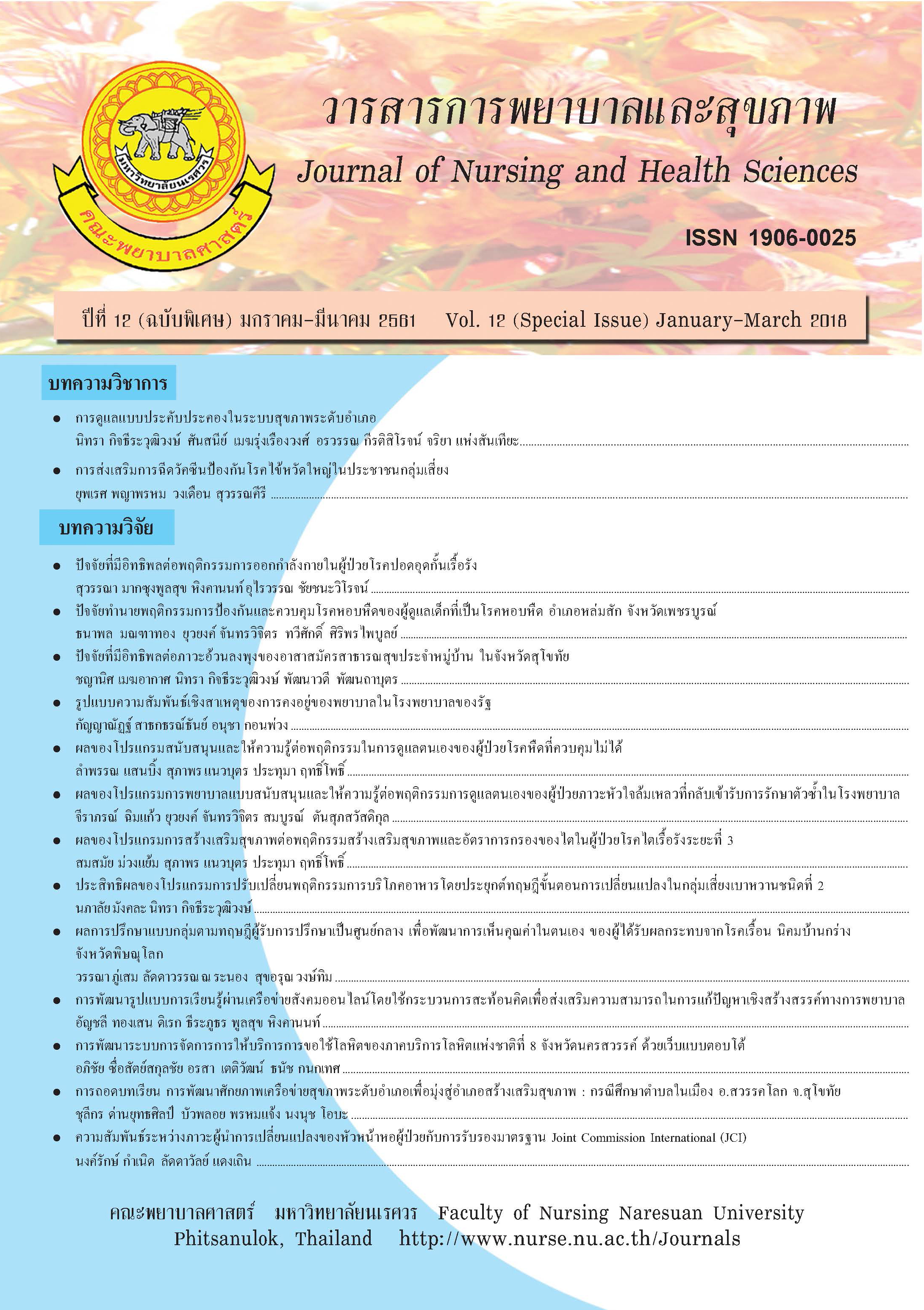รูปแบบความสัมพันธ์เชิงสาเหตุของการคงอยู่ของพยาบาลในโรงพยาบาลของรัฐ
Main Article Content
บทคัดย่อ
การวิจัยครั้งนี้เป็นวิจัยเชิงพรรณนาโดยมีวัตถุประสงค์การวิจัยเพื่อ คือ 1) สร้างรูปแบบเชิงสมมุติฐาน ความสัมพันธ์เชิงสาเหตุของการคงอยู่ในงานของพยาบาลในโรงพยาบาลของรัฐ กลุ่มตัวอย่างได้แก่ผู้บริหาร องค์การพยาบาลระดับสูงและนักวิชาการด้านการพยาบาลจำนวน 5 คน เครื่องมือที่ใช้คือแบบสัมภาษณ์ แบบมีโครงสร้าง วิเคราะห์ข้อมูลโดยการวิเคราะห์เนื้อหา 2) ตรวจสอบความสอดคล้องของรูปแบบความ สัมพันธ์เชิงสาเหตุของการคงอยู่ของพยาบาลในโรงพยาบาลของรัฐกับข้อมูลเชิงประจักษ์ กลุ่มตัวอย่าง คือ พยาบาลวิชาชีพที่ปฏิบัติงานในโรงพยาบาลในสังกัดกระทรวงสาธารณสุขจำนวน 600 คน เครื่องมือที่ใช้ เป็นแบบสอบถามความคิดเห็นเกี่ยวกับปัจจัยเชิงสาเหตุที่มีผลต่อการคงอยู่ในงานของพยาบาลในโรงพยาบาล ของรัฐแบบมาตรประมาณค่า วิเคราะห์ข้อมูลโดยวิเคราะห์องค์ประกอบเชิงยืนยันและวิเคราะห์สมการ เชิงโครงสร้าง(SEM) โดยใช้โปรแกรม M plus 3) เสนอแนะแนวทางการนำผลการพัฒนารูปแบบความ สัมพันธ์เชิงสาเหตุของการคงอยู่ในงานของพยาบาลในโรงพยาบาลของรัฐไปประยุกต์ใช้กลุ่มตัวอย่างได้แก่ ผู้บริหารองค์การพยาบาลระดับสูงจำนวน 3 คน เครื่องมือที่ใช้คือแบบสัมภาษณ์แบบมีโครงสร้าง วิเคราะห์ ข้อมูลโดยการวิเคราะห์เนื้อหา ผลการวิจัยพบว่า 1) รูปแบบเชิงสมมุติฐานความสัมพันธ์เชิงสาเหตุของการคงอยู่ในงานของพยาบาล ในโรงพยาบาลของรัฐประกอบด้วยตัวแปรต่างๆได้แก่ ลักษณะงาน พฤติกรรมของผู้บริหาร ระบบการจัดการ ทรัพยากรมนุษย์ ด้านองค์การ ปัจจัยส่วนบุคคล และด้านสัมพันธภาพของผู้ร่วมงาน 2) รูปแบบความสัมพันธ์ เชิงสาเหตุของการคงอยู่ในงานของพยาบาลในโรงพยาบาลของรัฐมีความสอดคล้องกับข้อมูลเชิงประจักษ์ อยู่ในเกณฑ์ดี โดยตัวแปรแฝงอื่นๆ ในรูปแบบสามารถอธิบายความแปรปรวนของตัวแปรแฝงการคงอยู่ใน งานของพยาบาลร้อยละ 42.10ตัวแปรที่ส่งผลทางตรงต่อการคงอยู่ของพยาบาลประกอบด้วยตัวแปรแฝงปัจจัย ส่วนบุคคล ลักษณะงาน และสัมพันธภาพของผู้ร่วมงานมีค่าอิทธิพลเท่ากับ 0.60, 0.46 และ -0.35 ตามลำดับ ปัจจัยองค์การส่งอิทธิพลทางตรงต่อลักษณะงาน และพฤติกรรมของผู้บริหาร เท่ากับ 0.92 และ0.84 ตามลำดับพฤติกรรมของผู้บริหารส่งอิทธิพลทางตรงต่อการจัดการทรัพยากรมนุษย์และสัมพันธภาพของผู้ร่วมงาน เท่ากับ 0.93และ 0.72 ตามลำดับระบบการจัดการทรัพยากรมนุษย์ส่งอิทธิพลทางตรงต่อปัจจัยส่วนบุคคล เท่ากับ1.90 ปัจจัยองค์การส่งอิทธิพลทางอ้อมต่อสัมพันธภาพของผู้ร่วมงานผ่านพฤติกรรมของผู้บริหาร เท่ากับ 0.62 ปัจจัยด้านองค์การส่งอิทธิพลทางอ้อมต่อระบบการจัดการทรัพยากรมนุษย์ผ่านพฤติกรรมของ ผู้บริหารเท่ากับ 0.81 3) ข้อเสนอแนะในการนำไปประยุกต์ใช้จากการสัมภาษณ์ผู้ทรงคุณวุฒิโดยประเด็น คำถามมาจากเส้นอิทธิพลที่ได้จากการวิเคราะห์ความสัมพันธ์เชิงสาเหตุพบว่าผู้บริหารโรงพยาบาลและ ผู้บริหารการพยาบาลควรให้ความสำคัญในด้านพฤติกรรมของผู้บริหารที่ส่งอิทธิพลต่อการจัดการทรัพยากร มนุษย์และด้านสัมพันธภาพของผู้ร่วมงานการจัดการทรัพยากรมนุษย์ที่ส่งอิทธิพลต่อโดยตรงพยาบาลและ ปัจจัยด้านองค์การที่ส่งอิทธิพลต่อลักษณะงานดังนั้นผู้บริหารควรมีบทบาทสำคัญในกำหนดนโยบายและ โครงสร้างบริหารในการสร้างลักษณะงานที่มีคุณค่าสร้างความมั่งคงต่อเนื่องในงาน สร้างบรรยากาศองค์การ ที่ดีและผู้บริหารควรวางระบบการจัดการทรัพยากรมนุษย์ในเรื่องแผนการพัฒนาบุคลากรพยาบาลอย่าง เป็นระบบ และเพื่อธำรงรักษาไว้ซึ่งบุคลากรพยาบาลตลอดจนการกำกับติดตามตลอดจนสนับสนุนเพื่อให้ พยาบาลมีความสมดุลในชีวิตและงานเกิดความพึงพอใจในงานและเกิดความผูกพันต่อองค์การตั้งใจที่จะอยู่ ในงานตลอดไปจนสามารถสร้างการคงอยู่ในงานได้ในที่สุด
Article Details
เอกสารอ้างอิง
เหตุไร้ความก้าวหน้า. สำนักข่าวผู้จัดการออนไลน์.
กรุงเทพฯ : โรงพิมพ์ตะวันออก.
กฤษดา แสวงดีและคณะ. (2552).สุขภาพและชีวิตการ
ทำงานของพยาบาลวิชาชีพในประเทศไทย.
นนทบุรี : สำนักงานพัฒนานโยบายสุขภาพ
ระดับประเทศ กระทรวงสาธารณสุข.
กฤษดา แสวงดี. (2551). สถานการณ์กำลังคนพยาบาล
วิชาชีพ ในประเทศไทย. วารสารวิจัยระบบ
สาธารณสุข. 2(1), 40- 6.)
_______. (2552). วิกฤตการณ์ของบุคลากรการ
พยาบาลสถานการณ์ในประเทศไทยเอกสาร
การนำเสนอในการวิจัยการพยาบาล : ผ่านวิกฤติ
เศรษฐกิจเพื่อสังคมเพื่อสุขภาพ.การประชุม
การวิจัยการพยาบาลเจนเนอเรชั่นที่ 4 : 2552
เดือนพฤศจิกายน 2-4 .กรุงเทพฯ ประเทศไทย.
_______. (2557). เจาะลึกระบบสุขภาพ :วอนแก้เกณฑ์
ความก้าวหน้าพยาบาลสธ. ชี้จะได้ซีเพิ่มต้อง
ยุบรวมตำแหน่ง.นนทบุรี : สำนักข่าวเจาะลึก
ระบบสุขภาพ บางใหญ่.
_______. (2560).วิกฤติขาดแคลนพยาบาลวิชาชีพ
ในหน่วยบริการสุขภาพของสำนักปลัดกระทรวง
สาธารณสุข : ข้อเสนอเชิงนโยบาย. นนทบุรี :
กระทรวงสาธารณสุข.
ธงชัย สันติวงษ์. (2545). การจัดการ.กรุงเทพฯ: สานัก
พิมพ์แห่งจุฬาลงกรณ์มหาวิทยาลัย.
นงนุช วงษ์สุวรรณ. (2553). การบริหารทรัพยากร
มนุษย์.กรุงเทพฯ: จามจุรีโปรดักส์.
นงลักษณ์ วิรัชชัย. (2542). โมเดลลิสเรล:สถิติวิเคราะห์
สำหรับการวิจัย. พิมพ์ครั้ง 3.กรุงเทพฯ :
จุฬาลงกรณมหาวิทยาลัย.
บงกชพรตั้งฉัตรชัย, บุญทิพย์สิริธรังศรี, สุพิมพ์ศรีพันธ์
วรสกุล, และวิไลพรรังควัต. (2554). ปัจจัย
ทำนายการคงอยู่ในงานของพยาบาลวิชาชีพ
โรงพยาบาลศูนย์เขตภาคตะวันออกเฉียงเหนือ
สังกัดกระทรวงสาธารณสุข. วารสารสภา
การพยาบาล. 26 (4), 43-54.
บุญใจ ศรีสถิตย์นรากูร. (2550). ภาวะผู้นำและกลยุทธ์
การจัดการองค์การพยาบาลในศตวรรษที่ 21.
(พิมพ์ครั้งที่ 2).กรุงเทพ : จุฬาลงกรณ์มหาวิทยาลัย.
ปรียาพร วงศ์อนุตรโรจน์. (2553). จิตวิทยาการบริหาร
งานบุคคล.กรุงเทพฯ: พิมพ์ดี.
มานิต นพอมรบดี. (2552). วิกฤตพยาบาล! แห่ลาออก
ปีละ 3 พันคนเด็กจบใหม่ไหลไปภาคเอกชน
เหตุเครียด-ภาระหนัก.ประชุมวิชาการชมรม
พยาบาลชุมชนแห่งประเทศไทยประจำปี 2551
(19 มกราคม 2552). กรุงเทพฯ : โรงพิมพ์ตะวันออก.
รวิสรา เผือกสิงห์, เรณุการ์ ทองคารอด, พูลสุข หิงคานนท์,
และสุภมาสอังศุโชติ. (2555). ปัจจัยที่มีอิทธิพล
ต่อการคงอยู่ในงานของพยาบาลวิชาชีพโรงพยาบาล
ชุมชนตามแนวชายแดนภาคเหนือประเทศไทย.
วารสารการพยาบาลและสุขภาพ. 6(3), 107-118.
วัชรา ขาวผ่อง. (2556). ปัจจัยทำนายความพึงพอใจ
ในงานและความตั้งใจคงอยู่ในงานของพยาบาล
วิชาชีพโรงพยาบาลเอกชนภาคตะวันออก
(วิทยานิพนธ์ปริญญามหาบัณฑิต). ชลบุรี:
มหาวิทยาลัยบูรพา.
วิจิตร ศรีสุพรรณ. (2551).สถานการณ์ด้านกำลัง
คนพยาบาลวิชาชีพในประเทศไทย.เอกสาร
การประชุมสภาการพยาบาล. นนทบุรี : สภาการ
พยาบาล.
วิจิตร ศรีสุพรรณและกฤษดา แสวงดี.(2555). ข้อเสนอแนะ
เชิงนโยบายในการแก้ปัญหาขาดแคลนพยาบาล
วิชาชีพในประเทศไทย. วารสารสภาการพยาบาล.
27(1), 5-12.
ศิริพร กัญชนะ.(2551). มาตรการแก้ไขวิกฤติขาดแคลน
พยาบาล: ทางออกวิกฤติพยาบาล. ในการประชุม
วิชาการสมาคมศิษย์เก่าวิทยาลัยบรมราชชนนี
กรุงเทพสานักการพยาบาลและกลุ่มภารกิจ
บริการวิชาการโรงพยาบาลราชวิถี. กรุงเทพฯ: โรง
พยาบาลราชวิถี.
สุมาลี อยู่ผ่อง, และบุญทิพย์ สิริธรังศรี. (2554). ปัจจัย
การคงอยู่ในงานของพยาบาลวิชาชีพงานพยาบาล
ศัลยกรรมโรงพยาบาลมหาวิทยาลัยในกรุงเทพฯ.
ในเอกสารประกอบการประชุมเสนองานวิจัย
ระดับบัณฑิต มหาวิทยาลัยสุโขทัยธรรมา
ธิราชครั้งที่ 4. นนทบุรี: มหาวิทยาลัยสุโขทัย
ธรรมาธิราช.
สำนักการพยาบาล. (2558). ฐานข้อมูลพยาบาลสำนัก
การพยาบาล ปีงบประมาณ 2558.นนทบุรี :
กระทรวงสาธารณสุข.
สุรัสวดี สุวรรณเวช. (2549). การสร้างรูปแบบความ
ผูกพันของพนักงานต่อองค์การ.วารสารข้าราชการ.
51(3), 9-12.
อรุณรัตน์ คันธา. (2557). ผลกระทบและทางออกของการ
ขาดแคลนกาลังคนทางการพยาบาลในประเทศ
ไทย. วารสารพยาบาลศาสตร์. 32(1), 81-90.
Herzberg, F., Mausner, B., &Snyderman, B. B.
(1959).The motivation to work (2nded.). New
York: John Wiley and Sons.
Kyndt, E., Dochy, F., Michielsen, M. &Moeyaert, B.
(2009).Employee Retention :Organisational
and Personal Perspectives.Vocations and
Learning. 2(3),195-215.
Mrayyan, M. T. (2005). Nurse job satisfaction and
retention: Comparing public to private hospitals
in Jordan. Journal of Research in Nursing
Management. 13, 40-50.
Mathis, R. L., & Jackson, J. H. (2004).Human resource
management.(10thed.). Singapore: Seng Lee
Press.
Rambur, B., McIntosh, B., Palumbo, M. V., &Reinier,
K. (2005). Education as a determinant of
career retention and job satisfaction among
registered nurses. Journal of Nursing
Scholarship. 37(2), 185-192.


